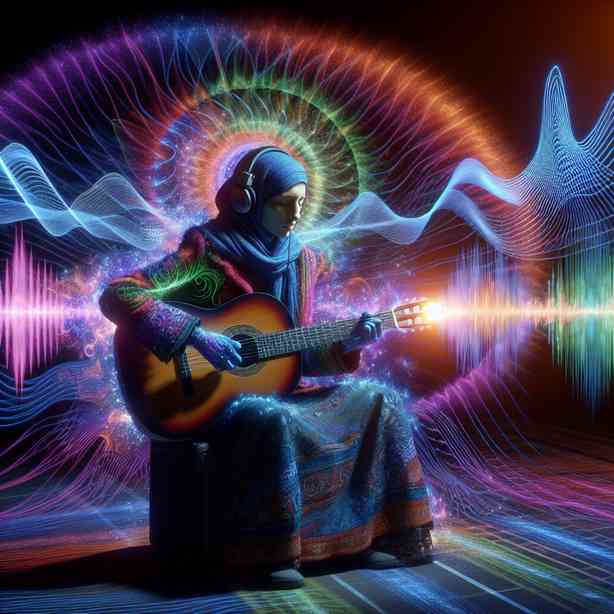
Reverb, or reverberation, serves as a fundamental element in music production and sound design, playing a profound role in conveying emotions and enhancing the listening experience. By creating a sense of space and depth, reverb can significantly influence how a listener perceives and feels about a piece of music or sound. In this exploration, we will delve into the various ways reverb impacts emotion, how it is utilized in different genres of music, and the psychological underpinnings of its effects.
Reverb can be understood as the persistence of sound after the original sound source has stopped. When we listen to music or any sound in a physical space, we are not just hearing the direct sound waves emitted by the source; we are also experiencing a complex interplay of sound reflections off walls, floors, and ceilings. This natural phenomenon creates a sonic environment that can evoke specific feelings and emotions. For instance, a large hall with extensive reverb can make a vocal performance feel majestic and ethereal, while a small, tightly constructed room with minimal reverb can create an intimate and immediate connection with the singer.
Emotionally, reverb can evoke a range of responses, from nostalgia to excitement. For example, in a melancholic ballad, lush reverb can enhance feelings of longing and sadness, enveloping the listener in a rich, warm texture that resonates deeply. Conversely, in energetic dance music, short and punchy reverb might add to the excitement and drive, creating an infectious energy that compels listeners to move. By manipulating reverb settings—such as decay time, pre-delay, and wet/dry mix—musical producers and sound designers can control the emotional landscape of a piece.
In various music genres, the application of reverb can follow distinct conventions that align with the genre’s emotional tone. In classical music, for example, reverb is often used to replicate the acoustics of grand concert halls, enhancing the lushness of orchestral arrangements and the emotional weight of solo performances. The expansive reverb envelopes the listener, transporting them into a realm of grandeur and beauty. In contrast, electronic music might often employ reverb more sparingly, using it to create tension or to build climaxes in an otherwise clean and precise sonic environment.
Furthermore, reverb can be a powerful storytelling tool in film and sound design. When combined with visual elements, the right amount of reverb can deepen the emotional impact of a scene. For instance, a character alone in a vast, echoing space may evoke feelings of isolation and despair. In contrast, a lively group scene in a bustling café might use subtle reverb to give a sense of warmth and community, making the dialogue feel more organic and immersive. This synergy between visual and auditory stimuli highlights how reverb contributes to narrative depth and character development, reinforcing the intended emotion.
The psychological aspects of reverb’s impact on emotion cannot be overlooked. From a cognitive perspective, reverb can manipulate the brain’s perception of time and space. Longer decay times may lead to a perception of slowing down, allowing the listener to linger on each note and lyric, thereby enhancing emotional engagement. This capability taps into fundamental human experiences and memories, often linked to certain sonic qualities that remind us of specific times and places in our lives. The brain’s association between certain reverb characteristics and past experiences contributes to the overall emotional response to music.
Additionally, reverb can facilitate emotional catharsis, especially in therapeutic settings. Music therapy has long utilized the properties of sound to help clients express emotions and process experiences. The enveloping quality of reverb can create a safe sound space where feelings can surface and be explored. In this context, music with rich reverb may allow individuals to connect with deeper emotions, leading to healing and resolution.
In modern music production, technology has greatly expanded the means by which artists can manipulate reverb. Digital reverb plugins provide an incredible array of options for producers and sound designers, from emulating the sounds of natural spaces like cathedrals and concert halls to creating completely unique and otherworldly atmospheres. This accessibility has democratized the creation of emotional soundscapes, allowing emerging artists to experiment with reverb techniques that previously required expensive recording studios or extensive technical knowledge.
Moreover, the role of reverb in live performances is equally significant. Sound engineers must consider the venue’s acoustics and the desired emotional effect when applying reverb to live sound. A well-timed reverb can enhance a vocalist’s performance, making their voice resonate beautifully throughout the space, captivating the audience and heightening the emotional connection during a live show. Audiences often respond to the sonic environment created by reverb, further amplifying their emotional engagement with the performance.
In conclusion, reverb is more than just an audio effect; it is a potent emotional tool that shapes how we experience sound and music. By creating depth, space, and an immersive auditory experience, reverb can evoke a wide range of emotions, enhancing our connection to music and storytelling. Whether through lush, expansive reverb in a symphonic orchestra or tight, punchy reverb in an electronic beat, the choices made in sound design and music production directly influence how a piece resonates with its audience. Understanding the emotional nuances of reverb not only rounds out the music production process but also enriches our appreciation of the complex relationship between sound, emotion, and human experience.


